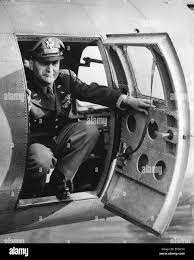Eighty years US B-17s bomb France in a militarily worthless propaganda operation
The US air force conducted its first heavy bomber raid on occupied Europe when twelve B-17s escorted by fifty or so RAF Spitfires attacked the large railway marshalling yards in Rouen. The purpose of the mssion was propagandistic and to put down a marker in inter-allied squabbles on strategy. An article by a well-placed British journalist, Peter Masefield who was soon to become a senior official at the Ministry of Aircraft Production, probably influenced by the RAF Air Staff had questioned severely the value of the daylight raids that the Americans planned along with the combat value of their aircraft. Masefield mused that Americans might soon be flying British - and implicitly more effective Lancasters against Germany. The RAF had not been impressed by the batch of B-17s that it had tried out. Damage to the target was minimal and there were two hundred French civilian casualties. The B-17s suffered no casulaties, but there was no mention of the large fighter escort in the press accounts of the mission. The US bomber commander General Ira Eaker, who had been on one of the B-17s, changed out of flying kit into dress uniform for a photo-call with the journalists massed for the aircraft's return. The pilot of the lead B-17, Major Paul Tibbets, went on to fly the B-29 that dropped the first atomic bomb on Hiroshima, neatly book-ending US strategic bomber operations in the Second World War.
Winston Churchill travelled to Moscow by air from Cairo via Teheran. It was an arduous journey for a man of 65 who was not physically fit, but he was determined to convince Stalin of Britain's resolution and to pre-empt disturbing rumours that he was willing to negotiate a separate peace. Some of the conversations were stormy and deeply offensive to the prime minister; Stalin accused the British of cowardice. No convenient opportunity arose to make any representations on behalf of the Free Poles - General Anders had accompanied the British delegation - but proved possible to tell Stalin that there would be no cross-Channel invasion that year without provoking an outburst. The final communique also bound the Soviets to fight until victory.
Five merchant ships from the British Pedestal convoy, including the tanker Ohio, so severely damaged as to be barely afloat, reached Malta. The other nine, along with RN aircraft carrier Eagle, cruisers Manchester and Cairo, and destroyer Foresight, were sunk in ferocious battles with Axis air, surface and submarine forces. Five other warships including aircraft carrier Indomitable were severely damaged. The Italian navy had two cruisers badly damaged and two submarines sunk; Axis air forces lost sixty or so aircraft. The supplies saved Malta from the near-certainty of being forced to surrender; it was an immensely costly strategic victory



Comments
Post a Comment